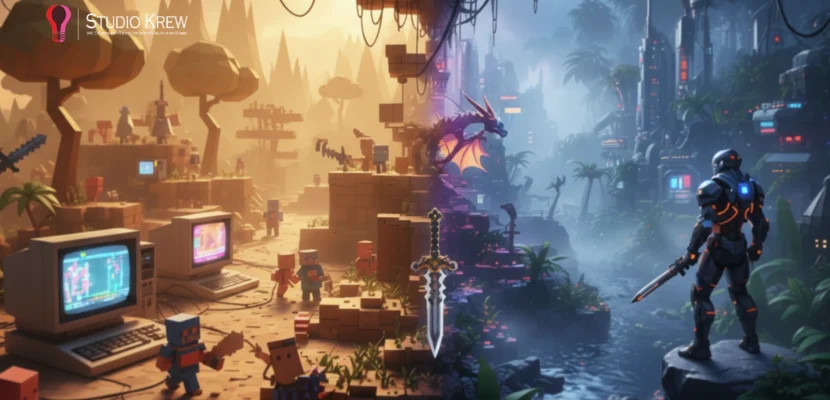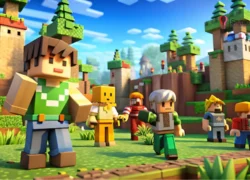Introduction: Why Everyone’s Talking About Game Remakes and Remasters
The rise of game remakes and remasters, from Resident Evil 4 Remake to Skyrim Special Edition, reflects a nostalgia-driven movement that has become a massive trend in the game industry. However, the terms “Remake” and “Remaster” are often confused, prompting the essential question: what exactly distinguishes a remake from a remaster?
Simply put, a game remaster polishes the original with better visuals, smoother frame rates, and improved audio. A game remake, on the other hand, rebuilds the classic from the ground up using modern tools, engines, and design standards. Both aim to keep beloved titles relevant for new hardware and new generations of players.
So, why is this trend growing so rapidly?
Nostalgia sells, and modern technology now makes it easier than ever to revive old favorites. The Game Remake vs. Remaster trend is changing how studios approach their IP libraries, opening up new opportunities for monetization, fan engagement, and brand revival.
At StudioKrew, we see this shift as more than just a trend; it’s a creative renaissance. Our teams combine the art of preservation with next-generation innovation to help developers rebuild timeless experiences that feel new again. Whether it’s a AAA Game Remake or a modernized Custom Game Revamp, we create solutions that honor the past and prepare for the future.
Next, let’s delve into how remakes and remasters differ in purpose, design, economics, and technology—and why these distinctions matter for both players and creators.
What is a Remaster?
A remaster is a refreshed version of an existing game that updates visuals, performance, and sound — but retains the original codebase, design, and core gameplay loop.
Think of it as polishing a classic without rewriting it.
Developers typically enhance textures, lighting, and resolution, upgrade frame rates, and add features like HDR support or improved audio mixing. The story, level design, and overall experience remain largely unchanged from the original.
Examples:
- The Witcher 3: Wild Hunt – Next-Gen Edition refined a 2015 classic for 4K and ray-tracing.
- Mass Effect Legendary Edition updated visuals, UI, and controls without changing mission structure.
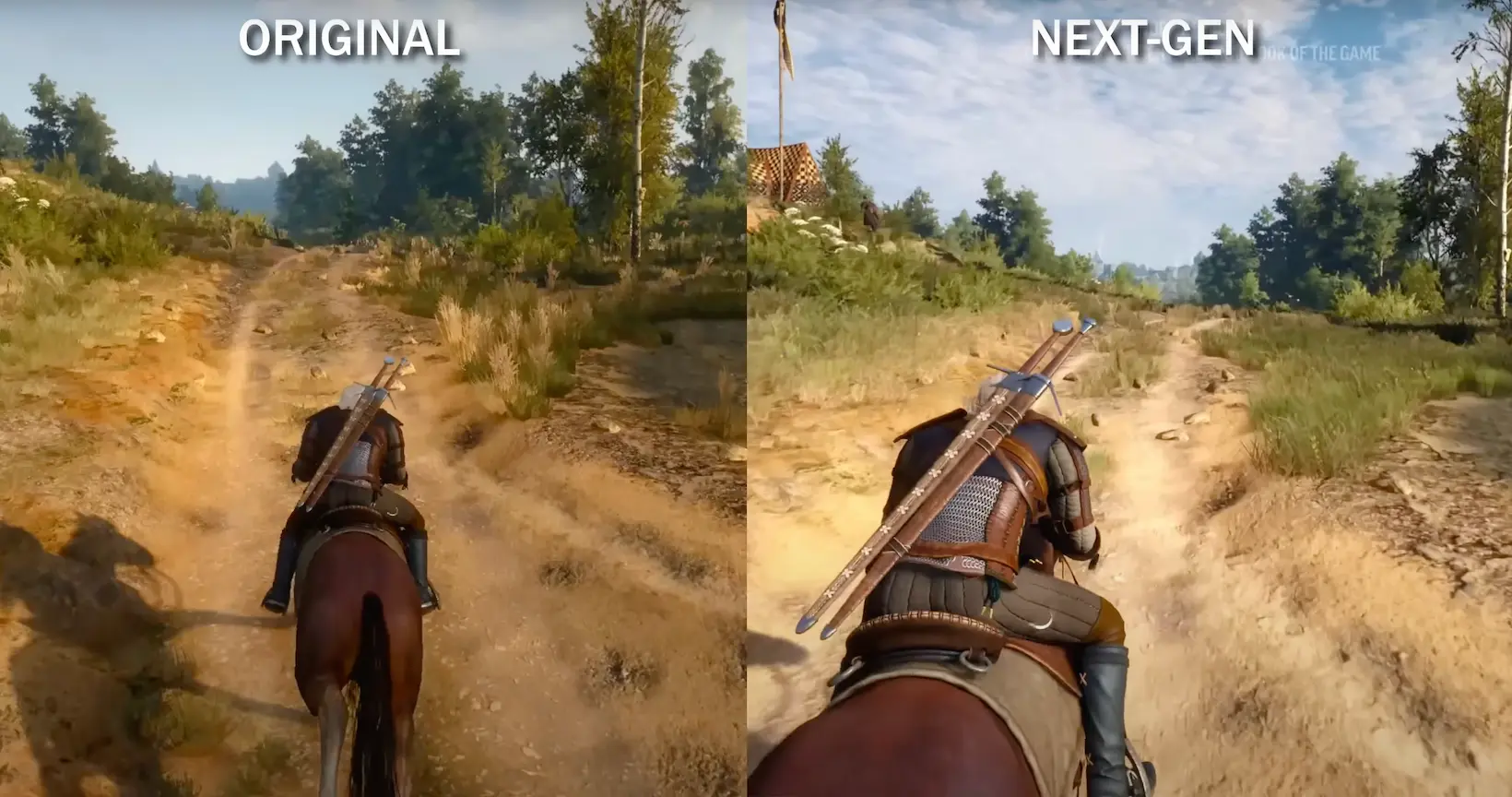
Remasters are faster and cheaper to produce — often seen as “preservation projects” that make older titles accessible to modern hardware.
At StudioKrew, we approach remasters with the same philosophy: keep the magic intact, enhance what time has aged, and deliver performance and visual fidelity that meet current-generation expectations.
What is a Remake?
A remake goes several steps further — it’s a complete rebuild of a game using modern technology, engines, and design principles.
The core story or theme may remain, but everything, from mechanics to art, level structure, and voice acting, is reimagined for a new generation.
In a remake, developers rebuild the world using new technology, updating animations, AI, and camera systems to deliver a modern experience.
Examples:
- Resident Evil 4 Remake rebuilt every asset and gameplay system to fit today’s action standards.
- Final Fantasy VII Remake expanded the original’s linear design into a full cinematic RPG.
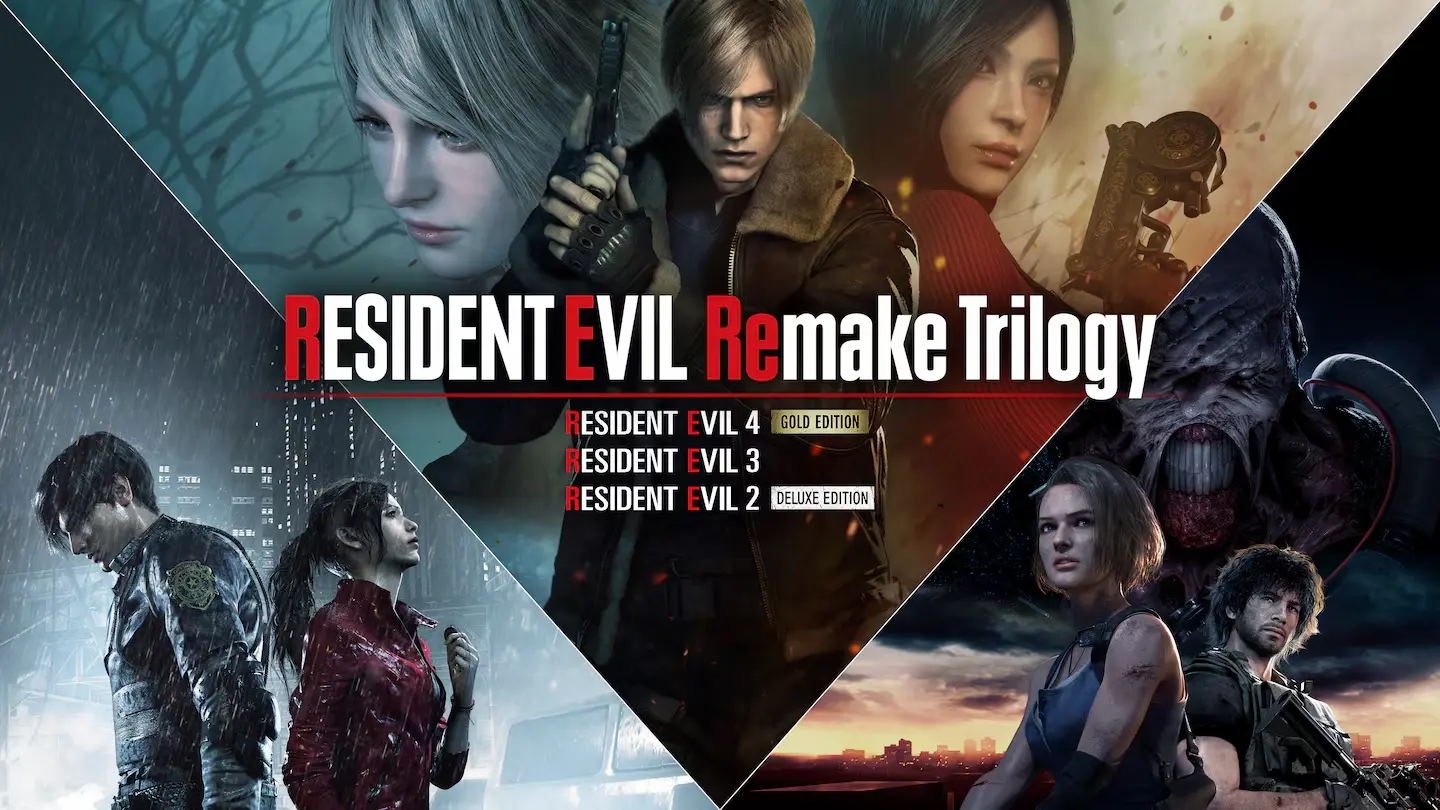
Remakes require longer development cycles and higher budgets — but they also have higher ROI potential, especially when nostalgia and innovation align perfectly.
StudioKrew’s custom game development services often blend this philosophy — rebuilding mechanics while preserving the emotional tone and player connection.
Remaster vs Remake: How They Differ
| Feature | Remaster | Remake |
|---|---|---|
| Core Codebase | Uses original engine and assets | Rebuilt from scratch in a new engine |
| Gameplay Changes | Minimal | Significant overhaul and modernization |
| Graphics & Audio | Enhanced resolution, lighting, textures | Completely new art, animation, and sound design |
| Development Cost | $5M – $15M (avg) | $40M – $100M (avg) |
| Timeline | 8–12 months | 18–36 months |
| Risk Level | Low to Medium | Medium to High |
| Example Titles | The Witcher 3 Next-Gen, Mass Effect LE | Resident Evil 4 Remake, FFVII Remake |
In essence:
- A remaster preserves history.
- A remake redefines it.
Both serve different purposes — one honors nostalgia; the other revives it for a new era.
At StudioKrew, we help studios decide which path aligns with their creative goals and business vision, ensuring every modernization project connects emotionally while performing commercially.
From Graphics to Gameplay: The True Art Behind Game Remakes vs Remasters
Every gamer can sense the difference between a quick polish and a full-scale rebirth, even if they can’t always explain it. The distinction between a game remake and a game remaster goes deeper than visuals; it’s about the philosophy of rebuilding versus refining.
Visual Enhancements vs Mechanical Overhauls
A remaster focuses on upgrading the look and sound of an existing title while preserving its original gameplay logic and codebase. Developers enhance textures, lighting, and frame rates, re-record audio in higher fidelity, and ensure compatibility with modern consoles and PCs.
Examples like The Last of Us Part I or Skyrim Special Edition keep the same story and mechanics but feel smoother and more cinematic. It’s a technical facelift for a familiar favorite.
A remake, on the other hand, is a complete rebuild. Studios often move the entire experience to a new game engine such as Unreal Engine 5 or Unity HDRP, recreate animations, redesign combat systems, and modernize level flow. Resident Evil 4 Remake and Final Fantasy VII Remake show how a reimagined design can elevate an old classic into a next-generation experience.
At StudioKrew, we provide comprehensive support for refreshing legacy IPs by partnering with developers throughout every stage: from rebuilding environments and refining mechanics to optimizing art pipelines. Our process is designed to retain core identity while embedding modern technical standards, maximizing both commercial impact and player satisfaction.
Preserving the Original Soul
Whether you update or rebuild, the real art lies in preserving emotion. Fans don’t return to a beloved game for polygons; they return for how it made them feel.
A successful remake captures that nostalgia while fixing what time has exposed, such as clunky controls, outdated UI, or uneven pacing. Shadow of the Colossus (2018) is a masterclass in this balance: rebuilt entirely from the ground up, it looks breathtaking on modern consoles yet delivers the same quiet loneliness that defined the 2005 original.
In contrast, the GTA Trilogy Remastered shows how superficial updates can fall short. Improved visuals alone can’t mask technical glitches or lost atmosphere. That’s why our creative directors at StudioKrew focus on emotional continuity before touching the code.
When to Choose a Remake or a Remaster
From a studio’s perspective, choosing between a remake and a remaster comes down to scope, budget, and player expectation.
- Choose a remaster if your game’s core design still holds up — it’s faster to deliver, cost-effective, and great for testing audience interest.
- Choose a remake when the foundation feels outdated or the engine limits innovation. This approach breathes new life into dormant IPs and can reposition a franchise for the next decade.
Our Game Development experts at StudioKrew offer in-depth analysis to help partners make informed decisions between remakes and remasters. We assess market demand, address technical debt, and uncover creative opportunities so studios can maximize ROI and deliver player-focused experiences before production begins.
💬 Did You Know?
Capcom’s Resident Evil 2 Remake sold over 10 million copies, surpassing sales of the 1998 original within a year — proving that a well-executed remake can outshine the classic in both revenue and reputation.
The Psychology of Nostalgia – Why Players Love Revisiting Old Worlds
Why do players rush to buy games they’ve already played before? The answer isn’t just about graphics or gameplay; it’s about emotion. Nostalgia is one of the most powerful forces in gaming. It connects our memories, our sense of comfort, and our love for storytelling all at once.
The Game Remake vs Remaster wave is not just about re-releasing old titles; it’s about reigniting emotions tied to moments that defined a generation.
The Emotional Power of Familiar Worlds
Every gamer remembers the first time they defeated a boss, solved a tricky puzzle, or got lost in a digital landscape that felt larger than life. Revisiting that world years later feels like catching up with an old friend.
Remasters tap into that feeling of recognition. You get the same story, characters, and flow, but with the clarity of modern visuals. Remakes, however, go a step further by letting players rediscover the same story in a fresh, reimagined way.
At StudioKrew, we define our value by ensuring emotional continuity. By thoroughly analyzing the original game’s strengths, we guide studios to recapture its magic while meeting the expectations of today’s players—turning nostalgia into engagement and, ultimately, lasting loyalty.
Why Nostalgia Sells in Modern Game Design
According to a 2025 Statista report, over 47% of gamers aged 25–40 are more likely to purchase a remake or remaster if it’s tied to a game they played as teenagers. It’s not just about playing — it’s about reliving.
This psychological attachment explains why studios continue to revive older franchises rather than take risks on entirely new IPs. Games like Pokémon Brilliant Diamond & Shining Pearl and Crash Bandicoot N. Sane Trilogy thrive because they tap into nostalgia-driven buying behavior, pairing emotional familiarity with upgraded experiences.
Nostalgia-based development also benefits from cross-generational marketing. Older players introduce classics to younger audiences, which helps extend a franchise’s lifecycle.
Studio Perspective: Recreating Emotion, Not Just Graphics
When we help studios decide between a remake and a remaster, our discussions extend beyond visuals. The key question is: what emotional experience do we want the player to relive?
- If the emotional experience is intact, a remaster with minor polish may suffice.
- If the mechanics or pacing dilute the original excitement, a remake becomes necessary to restore that spark.
This focus on emotional experience embodies StudioKrew’s value. Our teams meticulously reconstruct the user experience flow, camera perspectives, and haptic feedback, ensuring that each remake or remaster authentically delivers the original’s emotional depth while maximizing appeal to both new and returning players.
💬 Did You Know?
Research by GameIndustry.biz has found that nostalgia-themed releases account for nearly 25% of total AAA game sales in recent years, driven by returning fan bases and emotional marketing strategies.
In short, nostalgia doesn’t just revive games — it revives relationships. The difference between a remake and a remaster lies in how deeply they connect with those memories.
Top 10 Best Game Remakes and Remasters of All Time (2025 Edition)
Remakes and remasters are no longer side projects; they’re milestones in gaming history. These ten titles exemplify the art of Game Remake vs. Remaster excellence, each demonstrating that nostalgia and innovation can coexist.
1. Resident Evil 4 Remake (2023)
- Metacritic: 93/100 | Steam Rating: 96% “Overwhelmingly Positive”
Capcom rebuilt its legendary horror shooter on the RE Engine, enhancing combat precision, atmospheric detail, and AI behavior. The result is a remake that feels modern while honoring every scream of the original from 2005. It delivers cinematic pacing, seamless cut-scenes, and the tight gunplay fans remember.
💡 Fun Fact: Sold 6 million+ copies in its first year, surpassing the original’s total sales.
🎮 The benchmark for faithful innovation.
2. Final Fantasy VII Rebirth (2024)
- Metacritic: 92/100 | Player Rating: 9.2/10 (PS5)
Square Enix reimagined Midgar into a sprawling open world, fusing real-time combat with cinematic storytelling. Its seamless character arcs and lush visuals expand the legacy without rewriting it. The music, pacing, and world-building demonstrate the emotional impact of remakes.

💡 Fun Fact: Crossed 5 million units sold within three months of launch.
✨ A remake that transcends memory into myth.
3. Dead Space Remake (2023)
- Metacritic: 89/100 | Steam Rating: 91% Positive
EA Motive transformed the 2008 sci-fi classic into a seamless horror experience. Dynamic lighting, 3D audio, and zero-loading zones immerse players in Isaac Clarke’s terror. This indicates that technical mastery can intensify psychological fear when it is handled with respect for the source.
💡 Fun Fact: Won “Best Audio Design” at The Game Awards 2023.
🧟 A remake that rebuilt terror from the inside out.
4. The Witcher 3: Wild Hunt – Next-Gen Edition (2023)
- Metacritic: 95/100 | Steam Rating: 97% “Overwhelmingly Positive”
CD Projekt Red’s visual and performance upgrade brought new life to a 2015 masterpiece. Ray-traced lighting, ultra-fast loading, and expanded camera options make every journey through the Continent feel fresh. It connects generations without sacrificing depth in storytelling.
💡 Fun Fact: After the update, The Witcher 3 exceeded 50 million sales worldwide.
⚔️ When a remaster becomes immortal.
5. The Last of Us Part I (2022)
- Metacritic: 88/100 | Player Rating: 8.8/10
Naughty Dog rebuilt its post-apocalyptic masterpiece for PS5 and PC, adding advanced facial animation and next-generation lighting. The emotional weight of Joel and Ellie’s journey feels even more profound through 4K cinematography and spatial audio. This is a perfect example of technology serving storytelling.
💡 Fun Fact: Sales spiked 370% after the HBO series premiere in 2023.
🎬 When cinema and gameplay become one.
6. Demon’s Souls (PS5, 2020)
- Metacritic: 92/100 | Player Rating: 9.0/10
Bluepoint Games created a visually stunning remake that preserves FromSoftware’s challenge and mystique. The game’s golden lighting, fluid combat, and re-orchestrated score make it a showcase for PS5 hardware and design discipline.
💡 Fun Fact: 70% of PS5 launch buyers purchased Demon’s Souls within the first month.
🔥 A souls-like reborn in true next-gen form.
7. Cyberpunk 2077: Ultimate Edition (2024)
- Metacritic: 90/100 (Post-Patch 1.6) | Steam Rating: 86% Positive
The Ultimate Edition transformed a once-criticized RPG into a benchmark for technical improvement. CD Projekt Red rebuilt AI routines, reworked combat, and integrated the Phantom Liberty expansion for a truly cohesive experience.
💡 Fun Fact: By 2025, it became the #1 most-played RPG on Steam Deck.
⚙️ Proof that even broken dreams can be rebuilt.
8. Red Dead Redemption Remaster (2024)
- Metacritic: 85/100 | Player Rating: 8.9/10
Rockstar’s return to the frontier brought new life to John Marston’s journey. Updated textures, HDR lighting, and cross-generation support brought the West back in style. This remaster focuses more on craftsmanship and respect for the original’s pacing than on innovation.
💡 Fun Fact: 2 million copies sold in its first 10 days.
🐎 A remaster that rides straight into modern hearts.
9. Tony Hawk’s Pro Skater 1 + 2 (2020)
- Metacritic: 89/100 | Player Rating: 9.1/10
Vicarious Visions captured the joy of the originals with fluid controls, reimagined parks, and a well-mixed nostalgic soundtrack. It brought arcade-style fun back to millions and showed why simple, skill-based design still works in 2025.
💡 Fun Fact: Sold 1 million copies in its first week — the fastest in franchise history.
🎶 A remake that made everyone pick up the board again.
10. Assassin’s Creed Mirage (2023)
- Metacritic: 78/100 | Player Rating: 8.5/10
Although technically a soft reboot, Mirage returns to the series’ roots with dense urban stealth and handcrafted parkour. Ubisoft’s focus on compact storytelling and classic assassinations earned praise from long-time fans.
💡 Fun Fact: Attracted the highest number of returning franchise players since Origins (2017).
🕵️ A return to form that proved smaller can be smarter.
What These Games Teach Us
Each title demonstrates how modern studios approach nostalgia in distinct ways. Some focus on rebuilding mechanics, while others refine memories. Together, they show that the Game Remake vs Remaster trend is not just about looking back, but about making the past playable for the future.
At StudioKrew, we use this same philosophy when revitalizing legacy titles. With Unreal Engine 5, Unity HDRP, and AI-driven asset pipelines, we help studios bring their most beloved worlds to new platforms, combining modern performance with timeless charm.
Remake vs Remaster Market Trends – How Nostalgia Became a $5B Industry
Remakes and remasters were once just a way to fill gaps between new releases, but they have now become one of the most profitable segments in gaming. By 2025, nostalgia is more than just an emotion; it’s a business model worth over $5 billion each year worldwide.
The Rise of the Nostalgia Economy
According to Newzoo and Statista (2025) reports, game remakes and remasters now account for nearly 12% of total AAA game revenues, up from just 3% in 2018.
What changed? Two major shifts:
- Next-gen hardware adoption, including PS5, Xbox Series X|S, and high-end PCs, demands optimized legacy titles.
- Emotional marketing: nostalgia sells better than new IPs with uncertain fan bases.
In other words, bringing back a proven title is safer, faster, and often more profitable than building a new one from scratch.
Cost vs Profit Analysis
| Project Type | Avg Budget (USD M) | Avg Revenue (USD M) | ROI % Range | Dev Cycle (Months) |
| Remake – AAA | 75 M | 350–600 M | 400–700 % | 24–36 |
| Remake – AA / Mid-Tier | 25 M | 80–150 M | 300–500 % | 18–24 |
| Remaster – Premium | 12 M | 30–45 M | 250–350 % | 10–12 |
| Remaster – Port / Mobile | 6 M | 15–25 M | 200–300 % | 6–9 |
📈 Example: Capcom’s Resident Evil 4 Remake ≈ $100 M budget → $600 M gross (6× ROI).
CD Projekt Red’s The Witcher 3 Next-Gen Update ≈ $10 M budget → >$60 M incremental sales.
Global Player Behavior in 2025
- North America & Europe: Highest remake sales, driven by nostalgia-heavy franchises (Resident Evil, Final Fantasy, The Last of Us).
- Asia-Pacific: Demand led by visual quality and mobile remasters, especially in Japan and South Korea.
- India & UAE: Rapidly emerging markets for mobile and cloud-based remasters, as new-gen accessibility grows.
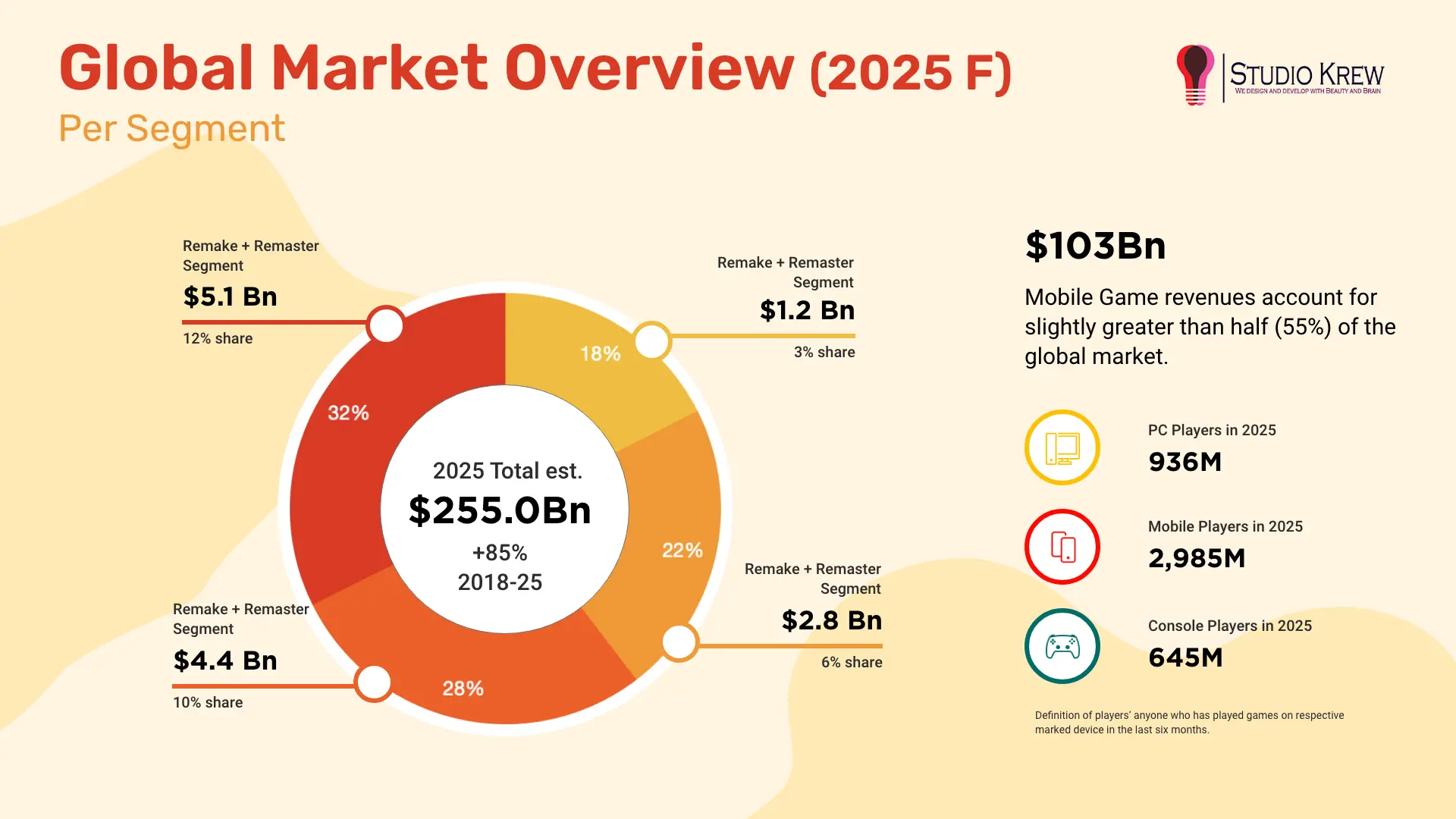
At StudioKrew, we’re seeing similar trends among our clients, especially publishers looking to bring legacy console titles into high-performing mobile and cross-platform ecosystems.
Why Studios Are Betting on Proven IPs
Reviving an existing franchise cuts both development time and marketing costs. A familiar IP brings built-in trust and audience memory, allowing studios to focus their budget on modernization rather than awareness.
For example:
- Resident Evil 4 Remake generated over $600 million in global sales in under a year.
- Final Fantasy VII Rebirth surpassed 5 million units sold within three months of release.
Such successes have reshaped production pipelines, leading many publishers to maintain dedicated Legacy Modernization Teams. These divisions focus entirely on refreshing old catalogues for new platforms.
At StudioKrew, our Game Co-Development Services play a similar role by helping large studios expand capacity for these revivals through scalable art, animation, and LiveOps support.
Trend Watch: AI and Automation in Modernization
AI-driven tools have further accelerated this growth. From texture upscaling to procedural world recreation, studios can now remaster titles faster and at lower cost.
By integrating AI-enhanced pipelines, StudioKrew’s AI Game Development Team enables publishers to restore visuals, refine animation fidelity, and automate performance testing, all while maintaining the creative authenticity of the original.
🎯 The Takeaway
The numbers tell a clear story: the remake vs remaster trend isn’t just a passing wave. It’s a long-term strategy that is reshaping how studios manage their IP lifecycles. Nostalgia, when combined with next-gen technology and smart production design, is now one of gaming’s most reliable revenue engines.
Next, we’ll explore the economics behind these decisions — how studios weigh costs, risks, and ROI when choosing between a remake or remaster, and how those choices influence timelines, monetization, and brand longevity.
The Economics of Remake vs Remaster: When Nostalgia Meets ROI
Behind every successful game remake or remaster is a careful balance of creativity and commercial sense. For studios, these projects aren’t just passion revivals; they’re high-stakes investments with clear ROI goals. Understanding where money flows and how profits scale helps explain why nostalgia has become one of the most bankable forces in modern gaming.
Remakes: Bigger Risk, Bigger Reward
A remake is often a full-scale production, rebuilt from the ground up using modern engines, assets, and systems. This means a higher upfront investment, but also much greater potential for long-term returns.
On average, a AAA remake can cost anywhere from $40 to $100 million, but if executed well, the results are staggering. Resident Evil 4 Remake alone generated over $600 million in global sales within its first year, while Final Fantasy VII Remake continues to sell years after launch through expansions and next-gen upgrades.
Beyond sales, remakes offer deeper franchise renewal value. They breathe new life into dormant IPs and set the stage for sequels, spinoffs, or transmedia adaptations.
At StudioKrew, our approach to remakes prioritizes long-term scalability. We build modular game architectures and high-quality art pipelines that make future content updates easier and more cost-effective.
Remasters: Efficient, Agile, and Profitable
A remaster sits at the opposite end of the spectrum. It is lower in cost, has a shorter production cycle, and is ideal for testing audience interest. Budgets typically range between $5 million and $15 million, with average development timelines of 8 to 12 months.
Titles like Mass Effect Legendary Edition and The Witcher 3: Next-Gen Edition demonstrate how cost-effective remasters can yield impressive ROI, especially when coupled with digital re-releases and subscription platforms like Game Pass or PlayStation Plus.
Remasters also open doors for cross-platform expansion, allowing classic console titles to find new audiences on mobile, PC, or streaming platforms. This is an area where StudioKrew’s Mobile Game Development Services have helped partners repurpose existing game assets and adapt gameplay loops for modern devices. When comparing remakes vs remasters, the economics reveal two very different production models.
| Remake | $40M – $100M | 18–36 months | 300–500% ROI | Resident Evil 4 Remake (Capcom) |
| Remaster | $5M – $15M | 8–12 months | 200–300% ROI | Mass Effect Legendary Edition (BioWare) |
A remake often means rebuilding from the ground up, which requires new engines, design systems, and art direction. This increases the upfront cost but allows for modern monetization and media coverage similar to that of a new release.
For instance, Resident Evil 4 Remake cost roughly $100 million but generated over $600 million in its first year, a near sixfold return.
Remasters, on the other hand, are faster and much more affordable. They refresh visuals and performance while preserving gameplay, making them ideal for reviving engagement or preparing audiences for future sequels. However, frequent remasters without significant innovation can risk brand fatigue, especially among long-time fans who want more than just cosmetic upgrades.
Risk vs Reward Analysis
The economic decision between a remake and a remaster is as much about timing as it is about technology.
- Remakes = High Risk, High Reward
These projects require significant investment in creative teams, new technology stacks such as Unreal Engine 5 or Unity HDRP, and extended QA cycles. However, they have the potential to rebuild an entire franchise, rekindle old fan bases, and attract new audiences at the same time.
Examples: Final Fantasy VII Remake, Demon’s Souls, Dead Space. - Remasters = Lower Risk, Stable ROI
They’re efficient for keeping IPs relevant between major releases or reaching new players through subscription platforms like Xbox Game Pass or PlayStation Plus. Their smaller budgets allow studios to test demand before committing to full remakes.
Examples: The Witcher 3 Next-Gen Update, Skyrim Anniversary Edition.
At StudioKrew, our co-development teams use the same logic by evaluating development risk against projected engagement. This ensures that each modernization cycle delivers measurable results, not just visual improvements.
How Monetization Changes Between Versions
Modern remakes and remasters differ not just in design but in how they generate ongoing revenue.
Remakes open the door to:
- Full-price sales (treated as new AAA titles)
- Expansion DLCs and sequel opportunities
- Limited editions, merchandise tie-ins, and collector bundles
Remasters often rely on:
- Mid-tier pricing and digital re-releases
- Inclusion in subscription libraries (e.g., Game Pass, PS Plus)
- Cross-platform ports or cloud releases for wider reach
A remake can therefore extend far beyond initial sales by supporting post-launch DLC or even transmedia adaptations such as films, series, or spin-offs. Remasters usually prioritize volume over margin, using accessibility and digital storefront exposure.
StudioKrew’s Perspective: Smarter Development, Sustainable Returns
At StudioKrew, we’ve seen that profitability doesn’t always favor the bigger budget. Our cost-effective remake pipelines use AI-enhanced art upscaling, modular development, and cross-platform optimization, helping partners shorten development time while maintaining AAA-quality standards.
Our teams often approach modernization as a hybrid model. They start with a remaster-level foundation, updating art, UI, and performance, then gradually evolve gameplay and systems into a semi-remake over time. This staged approach helps control costs while keeping ROI predictable.
For mobile-focused studios and publishers, our Mobile Game Development Services extend this model by optimizing remasters and remakes for iOS, Android, and cloud streaming platforms. The result is faster delivery, wider player reach, and a monetization strategy that remains strong long after launch.
🎯 The Takeaway
From a business perspective, both remakes and remasters are profitable options, but the smartest studios know when to choose each. Remakes reignite brands and rebuild communities, while remasters preserve IP longevity and expand audiences.
Either way, with solid planning, technical discipline, and emotional awareness, nostalgia becomes more than just a feeling. It turns into a sustainable revenue engine for the future of gaming.
AI-Powered Remakes and Remasters – The Future of Game Preservation
Artificial Intelligence isn’t just changing how we build games; it’s also redefining how we preserve them. As the Game Remake vs Remaster trend matures, AI has become a driving force behind the modernization of classic titles, allowing studios to restore, enhance, and even recreate older experiences faster and more efficiently than ever before.
AI in Texture, Animation, and Audio Restoration
In traditional remastering, visual upgrades were manual and time-consuming. Artists had to upscale every texture, reanimate movements, and clean up legacy assets frame by frame. Today, AI-driven tools like NVIDIA DLSS, ESRGAN, and TensorFlow-based image upscalers can automatically enhance resolution, detail, and fidelity, cutting production time by up to 60%.
Similarly, AI-assisted animation mapping lets studios re-rig classic character skeletons for modern engines without losing authenticity. Even classic audio benefits, as neural restoration models can clean, balance, or recreate old recordings for next-generation sound systems.
At StudioKrew, our AI integration pipeline uses machine learning to upscale legacy assets, rebuild motion data, and generate adaptive lighting. This allows creative teams to focus on narrative and gameplay instead of repetitive restoration tasks.
Machine Learning for Intelligent Game Reconstruction
Modern remakes like Dead Space (2023) and Resident Evil 4 Remake already use AI for procedural rendering and adaptive environment optimization. These systems analyze how players move and adjust visual fidelity in real time.
In future development cycles, studios are expected to use AI to:
- Predict level flow and pacing based on user telemetry.
- Auto-optimize shaders and lighting during rebuild
- Generate contextual dialogue through natural language models.
- Automate QA testing for physics and collision detection
These breakthroughs don’t just save money; they also raise the creative potential of what a remake or remaster can achieve.
AI-Powered Porting & Multi-Platform Adaptation
With demand for cross-platform game development, AI is making porting smoother and more accurate than ever. Automated adaptation systems can reformat input systems, optimize performance for mobile chips, and even adjust camera logic for different aspect ratios, all while keeping the original experience intact.
Through our Custom Game Development Services, we’ve helped studios modernize legacy titles across PC, console, and mobile platforms — integrating AI-assisted porting pipelines to ensure consistent gameplay quality across all platforms.
Preserving History Through Technology
AI’s impact goes beyond modernization; it’s becoming a crucial part of digital game preservation. As physical media declines, classic titles risk being lost to outdated formats. AI-led reconstruction helps preserve these experiences for future generations, ensuring iconic worlds like Silent Hill, Deus Ex, or Bioshock remain playable for decades to come.
This blend of nostalgia and innovation is at the heart of StudioKrew’s philosophy: respecting history while building for the future. Our AI and engineering teams work together to help partners revive, remaster, and preserve titles that deserve a second life, doing so faster, smarter, and with creative integrity.
💬 Did You Know?
AI-powered remastering tools can process texture enhancements up to 20x faster than traditional manual workflows, reducing development costs by nearly 35% in full-scale modernization projects. (Source: GameTech Analytics, 2025)
AI isn’t replacing artistry; it’s amplifying it. The next decade of remakes and remasters won’t just revisit classics—it will reinvent how they’re remembered.
Cross-Platform Future – Beyond Remakes: Reimagining Games for a New Era
As technology evolves and players seamlessly transition between platforms, the future of game remakes and remasters extends far beyond mere visual upgrades. The new era of modernization isn’t just about rebuilding; it’s about reimagining how and where players experience their favorite worlds.
Today, gamers expect to start a quest on their console, continue it on mobile, and share it from the cloud, all without compromise. This evolution is changing how studios approach legacy IPs, leading to a new movement of cross-platform, connected remakes designed for longevity, not just nostalgia.
From Platform Exclusive to Platform Inclusive
The days when a remaster was tied to a single console generation are over. Modernization now means creating multi-device ecosystems, where performance, UI, and input systems adapt dynamically to different screens and controls.
Recent examples, such as Resident Evil 4 Remake (Cloud Edition) for Switch, Final Fantasy VII Remake on PC, and The Witcher 3 Next-Gen Edition across PS5 and Xbox, demonstrate how reimagined experiences thrive when players aren’t restricted by hardware.
At StudioKrew, we design game architectures with cross-platform scalability in mind, optimizing builds for performance parity across consoles, PC, and mobile devices while preserving each platform’s unique strengths.
Building Once, Playing Everywhere
The future of remakes lies in unified development pipelines — single-engine solutions that allow one build to be deployed across multiple environments with minimal rework.
Technologies like Unity’s Adaptive Performance and Unreal Engine 5’s Nanite, combined with cloud-based asset streaming, make this possible by automatically scaling visual fidelity and performance to match hardware capacity.
This approach allows remakes and remasters to reach wider audiences without doubling budgets. It’s a philosophy central to StudioKrew’s cross-platform game engineering. Our developers use smart asset optimization and procedural rendering to ensure the same world feels seamless, whether it’s experienced in 4K HDR or on a handheld device.
Mobile and Cloud: The Next Frontier for Remasters
By 2025, more than 60% of global players will interact with their favorite titles through mobile or cloud platforms. For many studios, this means expanding older titles into new ecosystems through adaptive remasters — scaled experiences that maintain narrative and gameplay depth without sacrificing accessibility.
Mobile remasters, such as GTA: San Andreas Definitive Edition and Call of Duty: Warzone Mobile, demonstrate how modernization now transcends platforms.
Through our Mobile Game Development Services and Cloud Application Development expertise, we help studios reimagine legacy titles as scalable, globally accessible experiences. We combine cloud saves, real-time sync, and cross-device continuity.
Future Outlook: Hybridization of Remakes
The next wave of modernization will likely blur the lines even more. Studios are already experimenting with “Remake+Expansion” hybrids—experiences that preserve the original story but add new playable chapters, characters, and DLC ecosystems.
This approach not only revives fan interest but also opens monetization opportunities post-launch through LiveOps, seasonal events, and multiplayer expansions.
Our Game LiveOps and Co-Development Team works with publishers to extend these experiences, turning nostalgic revivals into long-term, evolving universes.
💬 Did You Know?
As of 2025, over 70% of new remake or remaster releases are designed with at least two platform targets in mind — a dramatic shift from just 25% five years ago.
The Cross-Platform Advantage
In essence, cross-platform design has turned remakes into living, evolving ecosystems instead of static re-releases. The ability to connect devices, players, and experiences gives classic titles a new kind of longevity.
At StudioKrew, we see this as the natural evolution of modernization. It’s not just about preserving the past, but about building for the future. Our game development team’s expertise in cross-platform services ensures every remake or remaster can adapt, scale, and thrive wherever the player chooses to play.
Behind the Scenes – How StudioKrew Approaches Remake vs Remaster Projects
Every game revival begins with a story—not just the one on-screen, but also the one behind the scenes. We believe a game remake or remaster isn’t just about better graphics or faster performance. It’s about rebuilding emotion — rediscovering why players fell in love with a world in the first place, and ensuring that feeling still resonates in 2025 and beyond.
Our process is deeply collaborative, technical, and emotional all at once. It blends art restoration with engineering precision.
Step 1: Understanding the Legacy and Its Audience
Before we write a single line of code, we immerse ourselves in the original. We replay it, watch player reactions, read fan theories, and analyze what made it iconic. Was it the pacing? The character writing? The soundtrack that hit just right at level three?
This stage helps us define the soul of the game—what must never change. Then comes the market perspective: who’s waiting for this revival? Are you a fan of the legacy seeking nostalgia, or a new audience discovering it for the first time?
Our creative leads and analysts collaborate to strike the right balance between faithfulness and freshness. That decision, guided by both data and instinct, determines whether a project deserves a remaster’s polish or a remake’s reinvention.
At this stage, we often utilize our Custom Game Development Services to prototype new experiences while adhering to the original blueprint.
Step 2: Choosing the Right Engine for the Story
Once we know what to build, we choose how to build it.
For cinematic realism, we turn to Unreal Engine 5, leveraging Lumen and Nanite to achieve film-grade lighting and fidelity. For scalable, multi-platform experiences, we rely on Unity HDRP, perfect for PC, console, and mobile remasters.
The goal isn’t just to upgrade visuals; it’s to future-proof performance. Every texture, shader, and script is optimized for longevity, making sure the game runs beautifully for years after launch.
Our Game Development and AI Game Development teams work closely together, integrating machine learning into the pipeline to speed up asset reconstruction and animation retargeting. This keeps the process efficient without compromising artistry.
Step 3: Reimagining the Art and Gameplay
This is where nostalgia meets innovation.
Our artists treat every remake as a restoration project, preserving the identity of environments while modernizing textures, lighting, and atmosphere. Every blade of grass, every shadow, and every UI animation is refined to feel both familiar and new.
Meanwhile, the gameplay team works on rhythm. If the original had slow camera transitions or clunky combat, we refine it for today’s player expectations. Sometimes that means rebuilding mechanics; other times it means simply improving responsiveness or accessibility.
Every design choice is tested against a single question: Does it still feel like the game we loved — only better?
Our Entertainment Game Development Services ensure this balance stays intact from prototype to production.
Step 4: Testing with the Players Who Matter Most
When the first playable build is ready, we bring in both kinds of players — veterans of the original and newcomers who’ve never touched it.
Their feedback is invaluable. Veterans spot missing “soul moments”; new players point out where nostalgia gets in the way of flow.
Using AI-based QA tools and player analytics, we analyze movement heatmaps, input timings, and completion rates to fine-tune pacing, performance, and emotional responses. It’s not just testing for bugs; it’s testing for feeling.
Through Game Co-Development Services, we also collaborate with partner studios to refine gameplay loops, address balance issues, and optimize cross-platform performance before the game is released to the public.
Step 5: Launch, LiveOps, and the Long Game
For us, launch day is only the midpoint of the story.
Once a remake or remaster is released, our LiveOps teams track community response, patch performance, and plan future updates that extend longevity — such as new content modes, visual enhancements, or limited-time events.
We see post-launch support as an ongoing conversation between developers and players. With our Application Maintenance and Support capabilities, we make sure the game remains technically strong and emotionally relevant, because great games shouldn’t just return—they should stay.
💬 Studio Insight:
“When we remake a game, we’re not rebuilding it pixel by pixel — we’re rebuilding trust.
Trust that nostalgia can coexist with innovation, and that technology can serve memory rather than erase it.”
Through this approach, StudioKrew transforms legacy titles into living experiences built for new devices, modern audiences, and timeless emotion. Whether it’s an Unreal Engine 5 remake, an AI-driven remaster, or a cross-platform re-release, our mission remains the same:
to keep great games alive and make them unforgettable again.
Conclusion – The Past Rebuilt for the Future
The debate between a game remake and a remaster isn’t really about technology; it’s about legacy. Every great remake asks one question: How can we make players feel what they once felt, but stronger this time?
From pixelated beginnings to photorealistic worlds, the journey of modern game development has proven one truth: great ideas never age, they just evolve. What changes is the craft behind them—smarter pipelines, adaptive engines, and AI that accelerates artistry without replacing it.
For players, these revivals are portals back to moments that mattered. For developers, they are opportunities to blend nostalgia with innovation and remind the world why a story, mechanic, or melody was timeless in the first place. For the industry, they show that emotional design and technical evolution can coexist beautifully.
At StudioKrew, this belief guides our approach to work. We treat every remake or remaster as both a creative challenge and a promise: to respect what made the original great while building something that stands proudly in the present. From AAA game remakes to AI-assisted remasters, our goal is simple: preserve the soul, refine the experience, and prepare it for the next generation of players.
Because in the end, every remake and remaster is more than just a return; it’s a rebirth. As long as there are players who remember, there will always be creators ready to rebuild those worlds for tomorrow.
